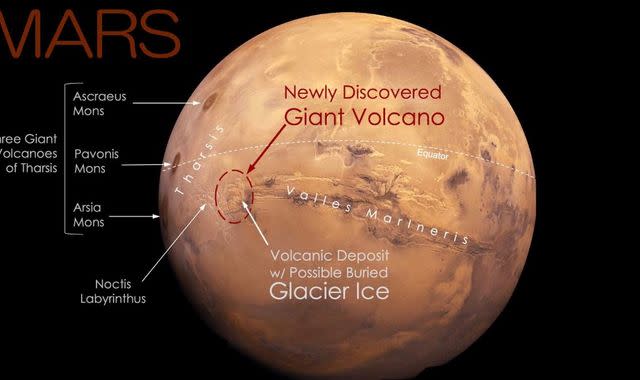Giant volcano spanning 280 miles discovered on Mars, scientists say

An enormous volcano has been "hiding in plain sight" on Mars for decades, according to scientists.
The volcano, which is 280 miles wide, was found alongside a possible sheet of buried glacier ice in the eastern part of Mars' Tharsis volcanic province, near the planet's equator, scientists revealed at the 55th Lunar and Planetary Science Conference held in Texas on Wednesday.
They said the volcano, which has been temporarily named the Noctis volcano in honour of its location at the edge of scenic Noctis Labyrinthus (Labyrinth of the Night), had been seen repeatedly by Nasa's orbiting spacecraft since 1971, but was deeply eroded and beyond easy recognition.
In a study about the discovery, the scientists said the volcano's size and "complex modification history" suggest it's been active for a very long time.
In its southeastern part, there's an area where glacier ice is likely still present, which scientists believe could be just as significant to us as the volcano.
They think the discoveries point to an "exciting new location to study Mars' geologic evolution through time, search for life, and explore with robots and humans in the future".
The discovery was made while a team of scientists was studying suspected glacier remnants and a potential landing site for astronauts nearby.
The study was a joint effort between the SETI Institute and the Mars Institute based at NASA Ames Research Centre.
Read more:
Discovery may explain why Martians don't exist
Likely cause of Mars' biggest ever quake revealed
Explaining how it happened, Dr Pascal Lee, planetary scientist and lead author of the study, said: "We were examining the geology of an area where we had found the remains of a glacier last year when we realised we were inside a huge and deeply eroded volcano."
Several clues gave away the volcanic nature of the jumble of layered hills and canyons found.
Here's a more in-depth description of the structure found in the eastern part of Noctis Labyrinthus, provided by the SETI Institute:
"This area of Mars is known to have a wide variety of hydrated minerals spanning a long stretch of Martian history, said Sourabh Shubham, the study's co-author.
"A volcanic setting for these minerals had long been suspected. So, it may not be too surprising to find a volcano here. In some sense, this large volcano is a long-sought 'smoking gun'."
Dr Lee says the Noctis volcano is so deeply eroded that "you could hike, drive, or fly through it to examine, sample, and date different parts of its interior to study Mars' evolution through time".
The scientists are now working on submitting their full study to a peer-reviewed publication.

